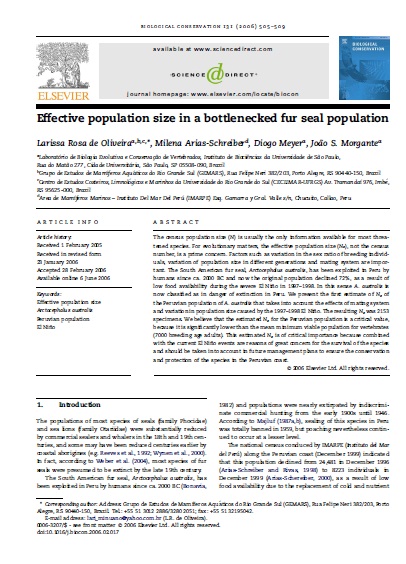چكیده
اندازه ی جمعیت سر شماری (N) معمولا تنها اطلاعات موجود برای تهدید شده ترین گونه ها می باشد.برای مسائل تکاملی اندازه ی موثر جمعیت (Ne) نه تعداد سرشماری یک نگراتی اولیه می باشد.عواملی مثل تغییرات در نسبت جنسیت تعداد زاد آوری تغییرات اندازه ی جمعیت از نسل های مختلف و سیستم جفت گیری مهم هستند از 2000 سال قبل از میلاد فوک خزدار آمریکای جنوبی Aretocephalus australis در پرو توسط انسان ها بهره برداری شده است و حالا جمعیت اصلی در نتیجه دسترس پذیری کم غذا در طی پدیده ال نینوی شدید 1998-1997،72%کاهش یافته است.در این زمینه A.autralisحالا در معرض خطر انقراض در پرو طبقه بندی می شود.ما اولین بر آورد Neجمعیت در پرو A.australisرا ارائه می دهیم که اثرات سیستم جفت گیری و تغییرات دراندازه ی جمعیت به واسطه ی ال نینوی 1998-1997 را در نظر می گیرد.Neحاصل 2153 نمونه بود.ما معتقدیم که Neبر آورد شده برای جمعیت پرو یک مقدار بحرانی می باشد چون به طور معنی داری کمتر از میانگین مینیمم جمعیت زیست پذیر برای مهره داران می باشد(7000 بالغ در سن زاد آوری) این Neبرآورد شده اهمیت فراوانی دارد چون همراه با رویداد های جاری ال نینو دلایل نگرانی فراوان برای بقای گونه هستند و بایستی در طرح های آتی مدیریت در نظر گرفته شوند تا محافظت اینگونه در سواحل پرو تضمین شود.
کلیدواژهها: اندازه مؤثر جمعیت، آرکتوسسالوس آسترالیس، جمعیت در پرو، ال نینو.
ABSTRACT
The census population size (N) is usually the only information available for most threatened species. For evolutionary matters, the effective population size (Ne), not the census number, is a prime concern. Factors such as variation in the sex ratio of breeding individuals, variation of population size in different generations and mating system are important. The South American fur seal, Arctocephalus australis, has been exploited in Peru by humans since ca. 2000 BC and now the original population declined 72%, as a result of low food availability during the severe El Nin˜ o in 1997–1998. In this sense A. australis is now classified as in danger of extinction in Peru. We present the first estimate of Ne of the Peruvian population of A. australis that takes into account the effects of mating system and variation in population size caused by the 1997–1998 El Nin˜ o. The resulting Ne was 2153 specimens. We believe that the estimated Ne for the Peruvian population is a critical value, because it is significantly lower than the mean minimum viable population for vertebrates (7000 breeding age adults). This estimated Ne is of critical importance because combined with the current El Nin˜ o events are reasons of great concern for the survival of the species and should be taken into account in future management plans to ensure the conservation and protection of the species in the Peruvian coast.
 قالبهای پاورپوینت
قالبهای پاورپوینت



نقد و بررسیها
هنوز بررسیای ثبت نشده است.